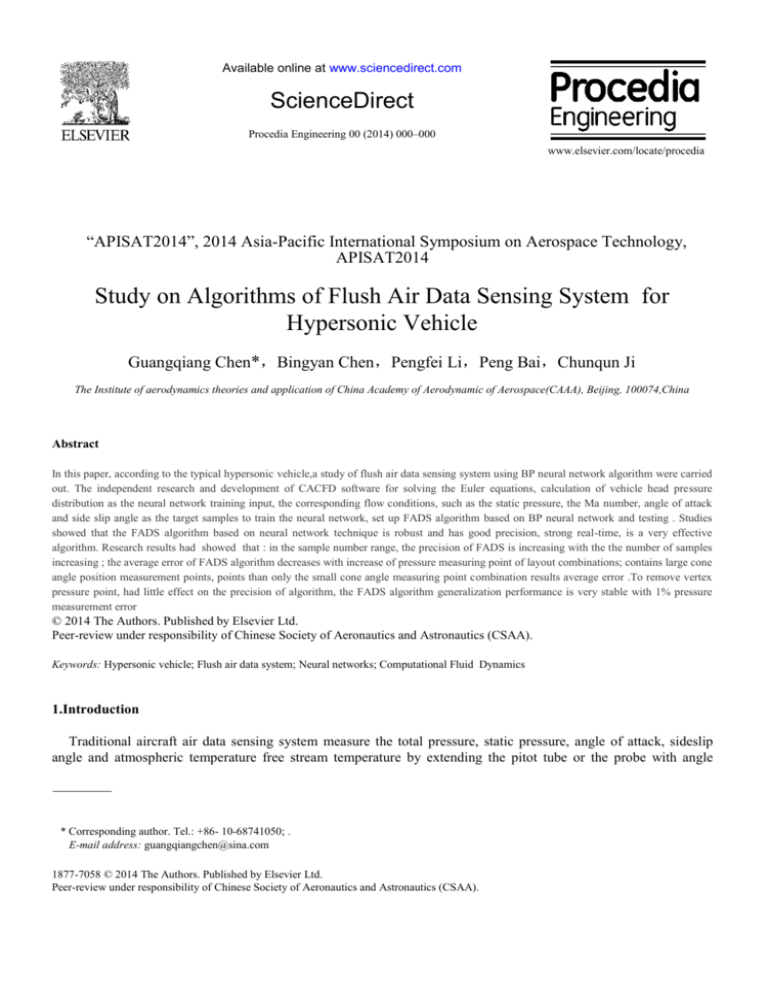randomly neural
advertisement

Available online at www.sciencedirect.com ScienceDirect Procedia Engineering 00 (2014) 000–000 www.elsevier.com/locate/procedia “APISAT2014”, 2014 Asia-Pacific International Symposium on Aerospace Technology, APISAT2014 Study on Algorithms of Flush Air Data Sensing System for Hypersonic Vehicle Guangqiang Chen*,Bingyan Chen,Pengfei Li,Peng Bai,Chunqun Ji The Institute of aerodynamics theories and application of China Academy of Aerodynamic of Aerospace(CAAA), Beijing, 100074,China Abstract In this paper, according to the typical hypersonic vehicle,a study of flush air data sensing system using BP neural network algorithm were carried out. The independent research and development of CACFD software for solving the Euler equations, calculation of vehicle head pressure distribution as the neural network training input, the corresponding flow conditions, such as the static pressure, the Ma number, angle of attack and side slip angle as the target samples to train the neural network, set up FADS algorithm based on BP neural network and testing . Studies showed that the FADS algorithm based on neural network technique is robust and has good precision, strong real-time, is a very effective algorithm. Research results had showed that : in the sample number range, the precision of FADS is increasing with the the number of samples increasing ; the average error of FADS algorithm decreases with increase of pressure measuring point of layout combinations; contains large cone angle position measurement points, points than only the small cone angle measuring point combination results average error .To remove vertex pressure point, had little effect on the precision of algorithm, the FADS algorithm generalization performance is very stable with 1% pressure measurement error © 2014 The Authors. Published by Elsevier Ltd. Peer-review under responsibility of Chinese Society of Aeronautics and Astronautics (CSAA). Keywords: Hypersonic vehicle; Flush air data system; Neural networks; Computational Fluid Dynamics 1.Introduction Traditional aircraft air data sensing system measure the total pressure, static pressure, angle of attack, sideslip angle and atmospheric temperature free stream temperature by extending the pitot tube or the probe with angle * Corresponding author. Tel.: +86- 10-68741050; . E-mail address: guangqiangchen@sina.com 1877-7058 © 2014 The Authors. Published by Elsevier Ltd. Peer-review under responsibility of Chinese Society of Aeronautics and Astronautics (CSAA). 2 Guangqiang Chen / Procedia Engineering 00 (2014) 000–000 sensor, which is shown in Figure 1 . With the rapid development of aerospace technology, the traditional extended tube measurement for air data sensing system is difficult to meet the demand of modern aircraft design. Fig. 1 The traditional extended tube measurement for Air Data System Fig.2 USA FADS development FADS (Flush Air Data System) depends on the pressure sensor array measurement of aircraft surface pressure distribution indirectly obtains dynamic pressure, total pressure, angle of attack, side slip angle and other atmospheric data through a specific algorithm. It can overcome the adverse effects the probe type pitot tube bring to hypersonic vehicle, stealth performance, high angle of attack maneuver, space layout size, and reduce the extra installation, use, maintenance costs, it also has the characteristics of high precision, wide application range etc.. FADS has been successfully applied to the X-15, F/A-18, X-31, X-33, X-34, X-38, X-43A and space shuttle and other types of aircraft [1-11],USA FADS development was shown in fig2. Japan in the last century 90's, carried out the research in FADS by the HYFLEX . The solution algorithm is one of the key technologies of FADS. In this study, according to the typical hypersonic vehicle, taking advantage of the strong nonlinear mapping ability of neural network, the numerical simulation software platform was the independent research and development CACFD ,which was applied to calculate surface array pressure of ball head shape, based on the BP neural network FADS algorithm and carry out a test and Analysis on the obtained data and conclusions, to lay the foundation for future development of hypersonic vehicle FADS. Guangqiang Chen / Procedia Engineering 00 (2014) 000–000 3 2.FADS algorithm based on BP neural network 2.1 Basic principle and working process The working principle of the FADS is shown in figure 3. Measurement of surface pressure point for the entire column pressure, as the angle of attack, side slip angle prediction, static pressure, dynamic pressure, the Ma number, speed vacuum, atmospheric density and pressure altitude and so on. The working flow of FADS is shown in figure 4. The establishment of FADS algorithm through the CFD numerical calculation and experimental data,makes the sensor to measure the pressure into the aircraft to air data, the calibration, and measurement data of inertial measurement system to obtain the final results fusion. Fig.3 The basic principle of FADS Fig.4 The work flow of FADS 2.2 FADS algorithm based on BP neural network BP neural network (back propagation) is a kind of using the error back-propagation neural network, it is the most essence part of artificial neural network. In the practical application of artificial neural network, most of the neural network model use BP network and its change form. Function approximation is an important direction of the application of BP neural network. According to the BP network theory: the two order continuous function f:[0,1]n → Rn given any a>0 and any, the existence of a three layer BP network, it can be in any a square error approximation accuracy in F, which means that the BP network can approximate any nonlinear continuous function of a two order. Therefore, BP has strong nonlinear mapping and infinite approximation ability. This study builds FADS algorithm based on BP neural network by using its character, as shown in figure 5. In order to reduce the calculation amount of training samples, improve the fitting precision,the network design is put into three layers of structure: divided into input layer, hidden layer and output layer; multiple input and single output, each air data sensing parameters individually using a neural network to fit; the input of the neural network for the pressure value, output static pressure P ∞ / Ma number/ attack angle α / side slip angle β. Fig.5 FADS algorithm based on BP neural network Fig.6 The ball head shape and Testing model of pressure array 4 Guangqiang Chen / Procedia Engineering 00 (2014) 000–000 3.Test results and analysis 3.1Test model introduction The test model was a typical ball head shape , which was the main characteristic of hypersonic vehicle head, and radius was 100mm. In order to ensure the stability of flow field, the ball was added with a length of 100mm cylinder, as shown in figure 6. Grid was a single zone structure grid, grid cells number is about 200000. The ball head pressure measuring point arrangement was shown in Figure 11, in accordance with the "cross" array arrangement pressure point, cone angle position were 10o, 20o, 30o, 40o, 50o and 60o, a total of 25 measuring points arrangement,as shown in figure 6. 3.2 Analysis of samples structural design and simulation results Air data sensing test range, namely the ball head of the hypersonic flow conditions, as shown in table 1. Static pressure was 0.1~0.5 atmospheric pressure, equivalent to an altitude of H=5km~16km. The pressure measuring points distribution was an array of cone angle (0o+ (30o+60o) × 4) (i.e. the head vertex, 30o angle and 60o angle position of the circumferential 0o, 90o, 180o and 270o), a total of 9 measuring points arrangement. The samples were divided into training samples and testing samples. There were 5 couples training samples which be randomly generated , the number of samples of the couples were 100, 200, 300, 400, 560. In order to test the accuracy of the algorithm, a couple of 50 randomly samples were generated in the range of test air data sensing as the FADS algorithm test data. Table1The precision FADS algorithm based on BP neural network Air data Measurement range Average error Average reference error Maximum error Statistic pressure P∞/(Atm) 0.1~0.5 0.006 1.2% 0.0215Atm 3.0~6.0 0.084 1.4% 0.2644 Attack angle α/(o) 0.0~10.0 0.032 0.3% 0.1140o slider angle β/(o) 0.0~5.0 0.023 0.4% 0.0728o Ma BP neural network FADS algorithm with 560 training samples , pressure point combination array is 0o+ (30o+60o) ×4, a total of 9 points. The test sample were a couple of 50 random samples. Suppose that the 9 pressure points of measurement error were in normal distribution, expectation is 0, variance σ 2 and 2 σ =Pi × 1%. 9 pressure points were randomly generated according to the normal distribution random number 100, shown in figure 7.The average standard deviation of the generalization error, calculation formula as shown in formula 1.Random measurement error in the pressure of 1%, BP neural network FADS algorithm based on the average standard deviation of generalization of static pressure, Ma number, angle of attack and side slip angle are: 0.0186Atm, 0.176, 0.137o, 0.104o.The average standard deviation of the test results of the generalization error as shown in figure 8~11. Fig. 7 Measurement points randomly generated 100 measurement error Guangqiang Chen / Procedia Engineering 00 (2014) 000–000 100 2 p 2 (P k 1 [i ,k ] sim Pt arg ) 2 5 [i ] 100 1 Fig8.The test sample static pressure generalization results and the average standard deviation Fig9.The test sample Ma number generalization results and the average standard deviation Fig10.The test sample attack angle generalization results and the average standard deviation (1) 6 Guangqiang Chen / Procedia Engineering 00 (2014) 000–000 Fig11.The test sample slider slip generalization results and the average standard deviation 4.Conclusion The results showed that, FADS algorithm based on neural network had better precision, robustness, real-time and large measuring range, which was a very effective algorithm. The research drawn the following conclusion: In a certain number of samples , the precision of FADS was increasing as the samples increased ; In contrast, the average prediction error of angle of attack and side slip angle were very small, of the Ma number and pressure were slightly larger; The average error algorithm and maximum error decreased along with the number of pressure point increment; Combinations contained large cone angle position measurement points had less error in results than only with small cone angle measurement combinations , removed the vertex pressure points, there was little impact in algorithm results; (5)1% of the pressure measurement error had little influence on the algorithm results, BP neural network generalization was very stable. References [1]Brent R. Cobleigh, Stephen A. Whitmore, and Edward A. Haering, Jr. Flush Air Data Sensing(FADS) System Calibration Procedures and Results for Blunt Forebodies[R]. NASA/TP- 1999-209012. [2] Detlef Rohlf, Oliver Brieger, ThomasGrohs. X-31 vector system identification-approach and results[C]. AIAA-2004-4830, 2004 [3]Judy L Shin. Comparison of predicted and experimental real-gas pressure distributions on space shuttle orbiter nose for shuttle entry air data system[R]. NASA/TP-1980-1627. [4]Terry J Larson, Paul M. Use of nose cap and fuselage pressure orifices for determination of air data for space shuttle orbiter below supersonic speeds[R]. NASA/TP-1980-1643. [5]Terry J Larson, Stuart G Flechner, Paul M. Wind tunnel investigation of an all flush orifice air data system for a large subsonic aircraft[R]. NASA/TP-1980-1642. [6] Terry J Larson, PaulM. Subsonic tests of an all-flush-pressure-orifice air data system[R]. NASA/TP-1981-1871. [7] Stephen AWhitmore, Timothy R Moes, Terry J Larson.Preliminary results from a subsonic high angle-of-attack flush air data sensing (HIFADS) system design calibra-tion and flight test evaluation[R]. NASA/TM-1990-101713. [8]Stephen AWhitmore. Development of a pneumatic high-angle-of-attack flush air data sensing (HI-FADS) system[R]. NASA/TM-1991104241. [9]Timothy R Moes, Stephen A Whitmore, Frank L Jordan Jr. Flight and wind-tunnel calibrations of a flush air data sensor at high angles of attack and side slip and at super-sonic mach numbers[C]. AIAA-93-1017, 1993 [10] Stephen AWhitmore, Timothy R Moes, Terry J Larson. High angle-of-attack flush air data sensing system[J]. Journal of aircraft. 1992, 29(5): 915-919. [11] Stephen AWhitmore, BrentR Cobleigh, Edward A Haering. Design and calibration of the X-33 flush air data sensing (FADS) system[C]. AIAA-98-0201, 1998.







